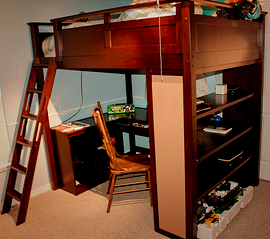Blog
Excuse Me, Your Biases are Showing
by Richard Sites, Studio Executive


You've Made Your Bed...
By Allen Interactions | August 17, 2011 | Custom Learning | 0 Comments

by Richard Sites, Studio Executive
Last year, my wife decided to buy our teenage daughter a loft bed—the big wooden kind with the desk and bookshelf underneath. Well of course the thing comes unassembled with 2,000 parts – 1,000 of which are long screws requiring an Allen wrench (you know, the small hexagonal tool bent at a right angle). Now, Allen wrenches are easy to use on one or two screws, but after 20-30, your knuckles are bruised and your fingers are blistered.
Normally, I would spread a project of this magnitude over the course of a weekend, but due to the fact that we had already donated our daughter’s previous bed, there was no time to waste.
After 3-4 hours of painful commitment to this task, I had successfully put all 2,000 pieces together! As I celebrated the completed project with an icy cool beverage, I thought of many things I could have done differently to get the job done quicker, lessening the blistering of my hands.
Well, fortunately a year later, my wife bought our son the same loft bed – what is it about kids and loft beds? But, having the opportunity to attempt the project again – this time with a few lessons learned – I was able to complete the bed much faster, and far less painfully.

Have you ever had a task or event that you wish you could do again? Of course! We all have. This is called knowledge: information and skills acquired through experience. Knowledge is a very important factor in our personal job growth and improved performance. Taking knowledge and carrying it over from one task to the next improves the quality of our work, our ideas and our strategic thinking.
But, what about the knowledge we gain from building an e-learning course?
e-Learning courses aren’t built on a Saturday. They occur over weeks and months. There’s a lot of time spent designing, discussing, reviewing and revising. During the project, we get the chance to try out things, consider new designs, test new strategies, edit the content and tweak the graphics. We are learning the whole time. And we should expect to know more at the end.
However, we shouldn’t let this new knowledge get in the way of our goal of creating and implementing quality e-learning on time and on budget. And when we do reach the end of our project, likely we will have many ideas for how the course could be better. And this realization often causes pain. We try to find wiggle room in the schedule to make that one last revision, swap out that one last image, and complete just one more review cycle. We start to assume because we can see that it is not perfect, others will too.
The truth is, we must deliver the training. Learners are waiting for this training – remember, the reason we started this project to begin with? Not delivering the training because we know more now than we did at the beginning of the project is akin to me disassembling my daughter’s bed just to put it together faster and easier than I did the first time. That’s not where my knowledge is beneficial! It’s the next time I am faced with the same task – my son’s bed, for example – that those lessons learned offer the most impact.
As professionals, we can appreciate the impact that making one more round of revisions will have on the success of the project. Our job is to account for this common phenomenon by incorporating potential improvements as early as possible. This will help to ensure the e-learning is the best it could be given the time and resources. But, we also must realize that this “one last” round of revisions will likely lead to new content, new graphics, new interactions – and with that, the desire to make even more revisions. The cycle of “perfecting” has to end sometime, why not now?
So, just ask yourself, is there any project or task that you wouldn’t do a better job of the second time around?
Mine is this blog post.
.png?width=135&height=135&name=ai-symbol-green%20(3).png)
About the Author: Allen Interactions
Comments
Would you like to leave a comment?
Related Blog Posts

By: Allen Interactions | Oct, 2012
Category: Custom Learning

Blog
What's Your Recipe for e-Learning?
by Richard Sites, Studio Executive
By: Allen Interactions | Aug, 2010
Category: Custom Learning

Blog
Lessons From Broadway—7 Important Ways to Improve Your e-Learning Design
by Richard Sites, Studio Executive
By: Allen Interactions | May, 2012
Category: Custom Learning
